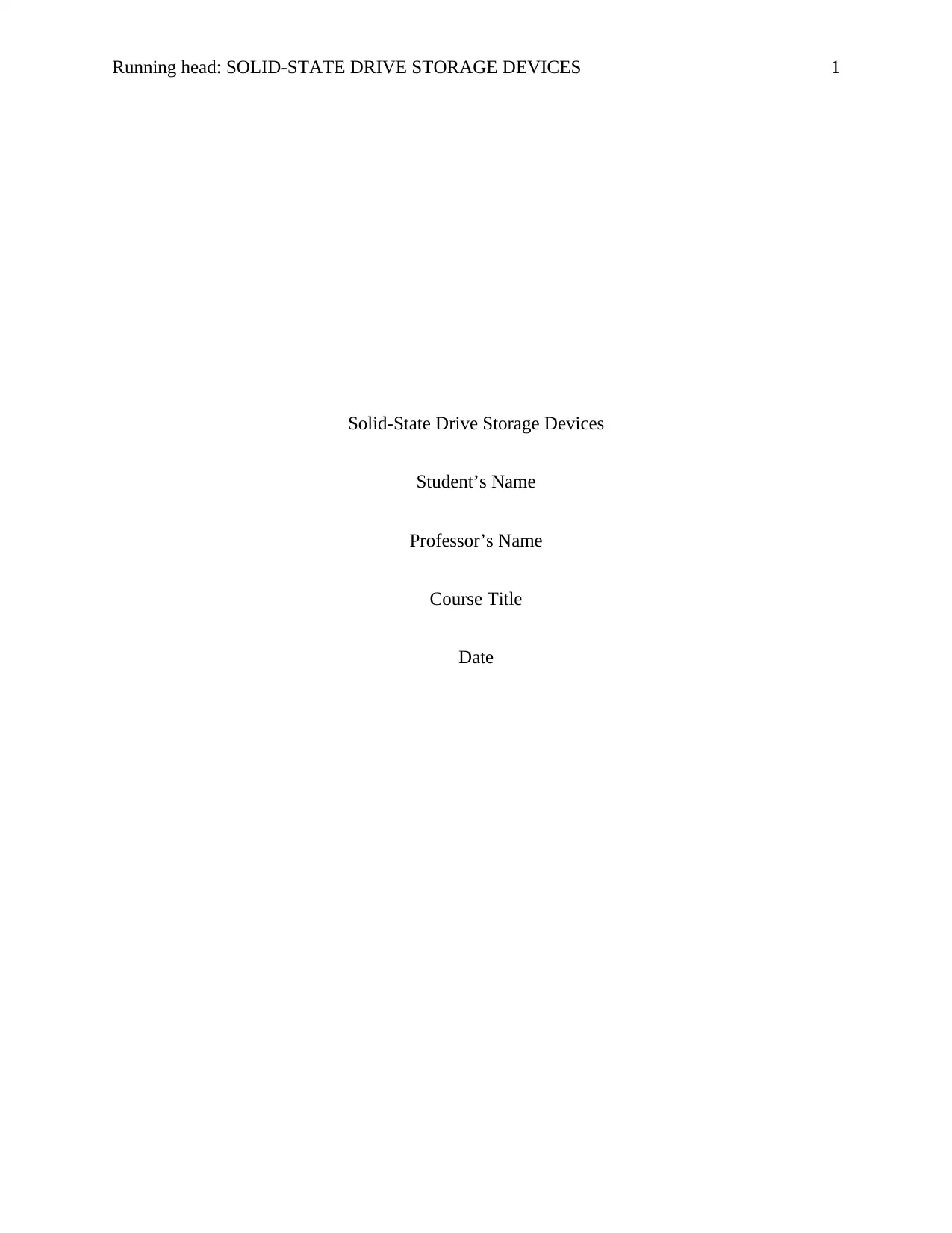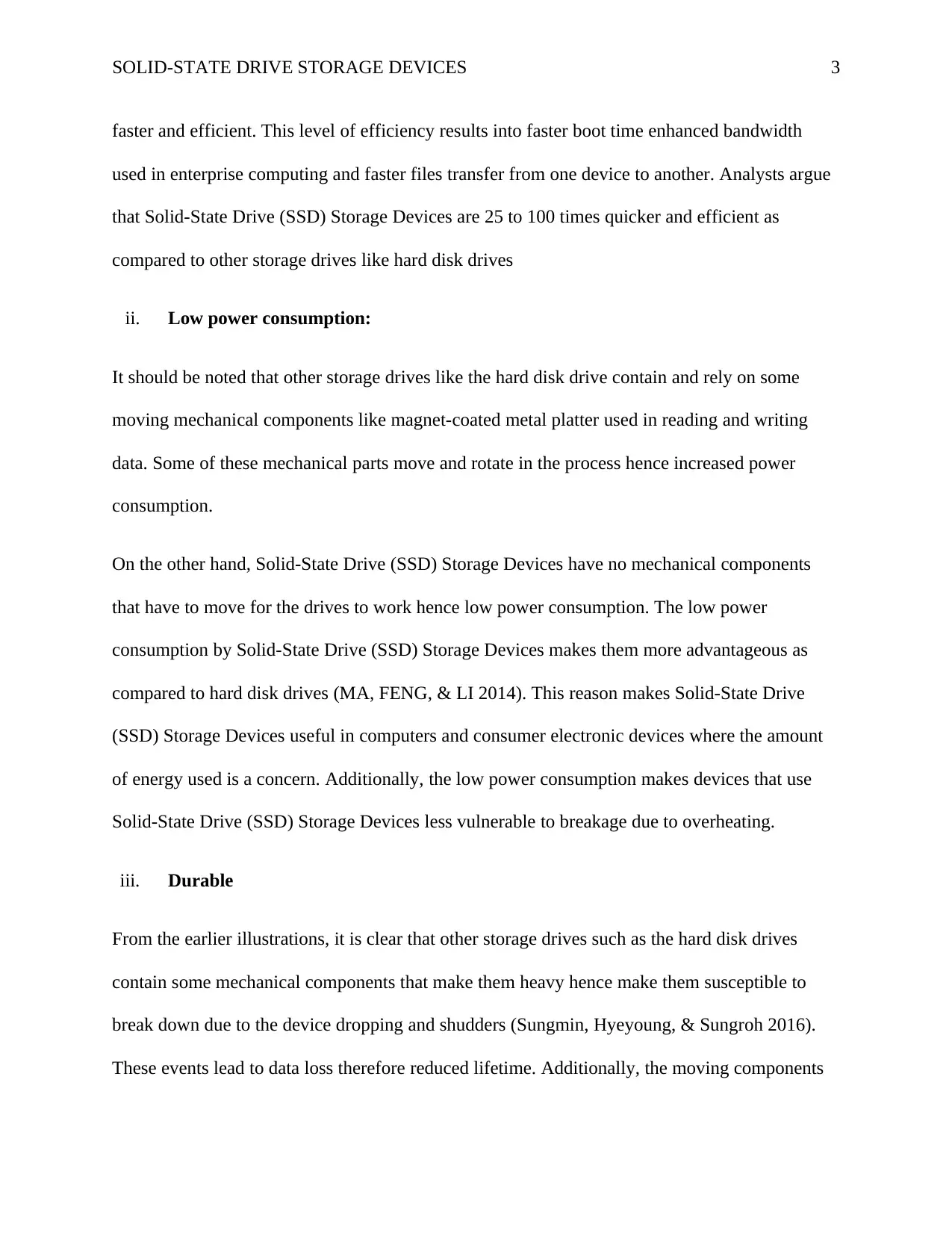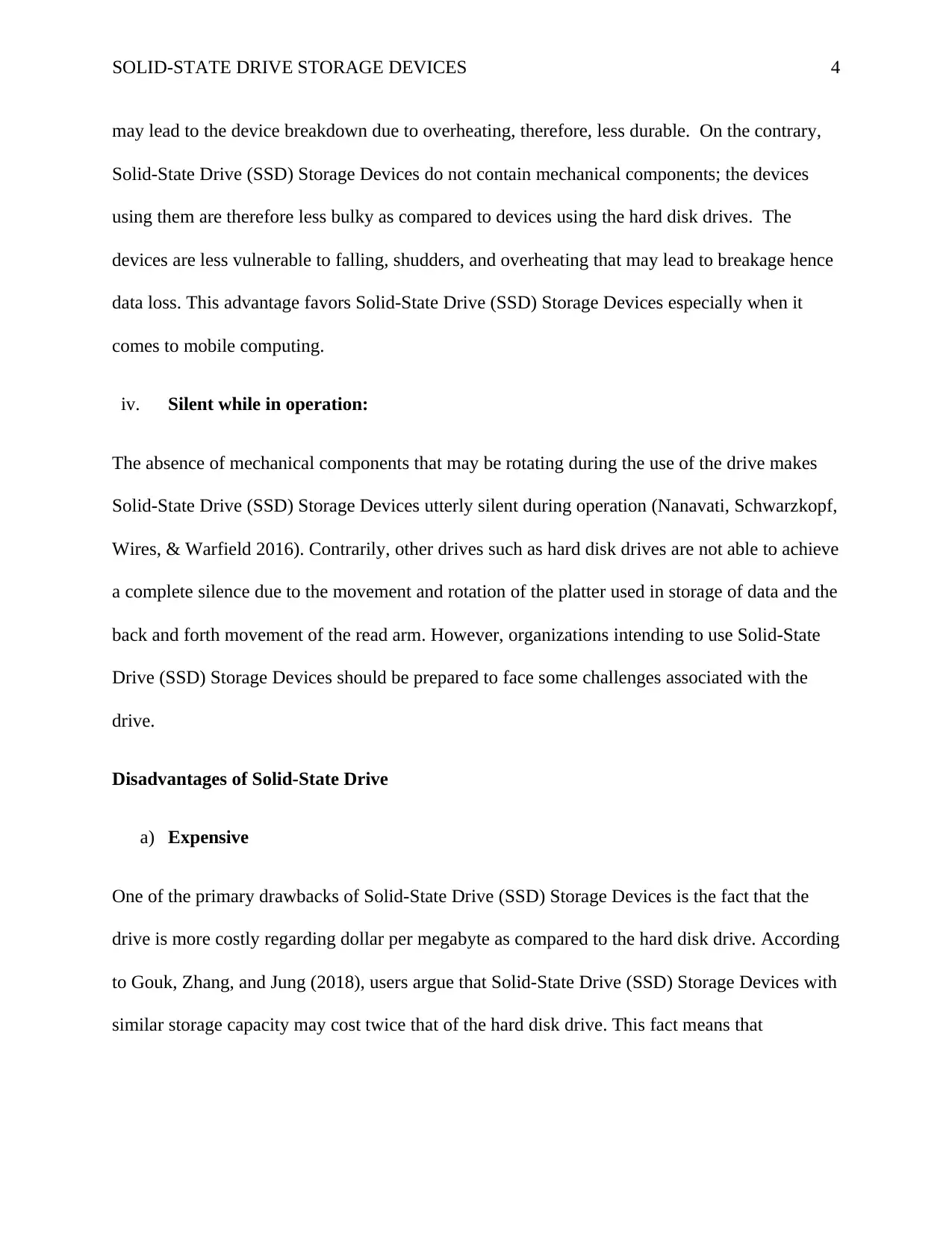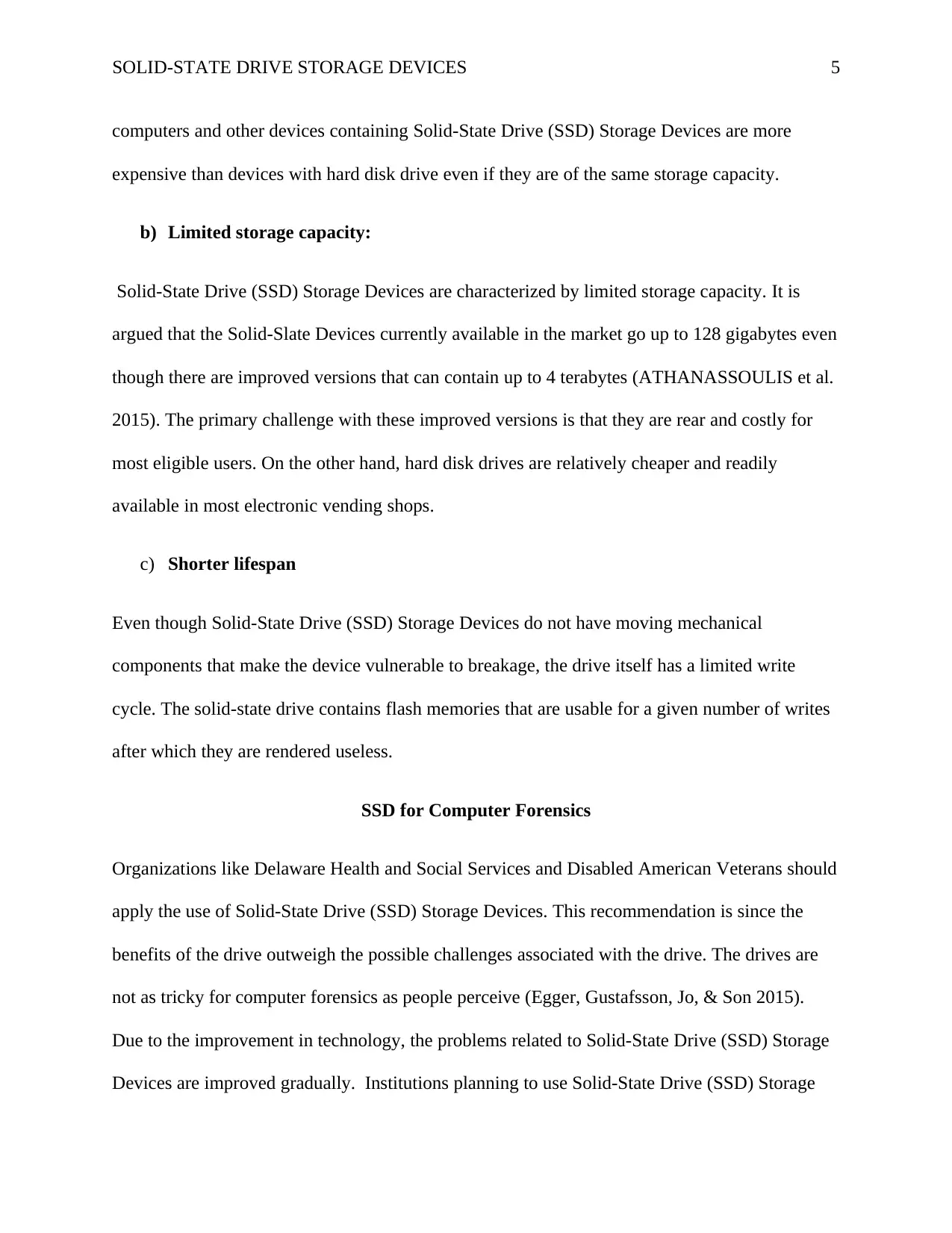Comprehensive Report: Solid-State Drive (SSD) Storage Devices
VerifiedAdded on 2021/09/27
|8
|1571
|183
Report
AI Summary
This report provides a comprehensive overview of Solid-State Drive (SSD) storage devices. It begins with an introduction to SSDs, explaining their structure and how they differ from traditional hard drives. The report details the advantages of SSDs, including faster speeds, lower power consumption, durability, and silent operation. It also addresses the disadvantages, such as higher cost and limited storage capacity. The report explores the application of SSDs in computer forensics and concludes with a discussion of their suitability for various uses. The report also includes a list of references to support the information presented.

Running head: SOLID-STATE DRIVE STORAGE DEVICES 1
Solid-State Drive Storage Devices
Student’s Name
Professor’s Name
Course Title
Date
Solid-State Drive Storage Devices
Student’s Name
Professor’s Name
Course Title
Date
Paraphrase This Document
Need a fresh take? Get an instant paraphrase of this document with our AI Paraphraser

SOLID-STATE DRIVE STORAGE DEVICES 2
Introduction
Solid-State Drive (SSD) Storage Device is a storage device whose memory of storing
data is made of integrated circuit assemblies; it does not have a physical a physical disk. This
device can use the form factors of hard drives such as SATA and SAS which end up simplifying
the invention on the computer (Hsieh, Lin, & Yang 2014). The software has undergone a lot of
developments in the recent past including the introduction of new form factors like M.2 and
NVM Express to address some specific requirements in the device. One of the main differences
between the Solid-State Drive (SSD) Storage Devices and other conventional electromechanical
drives is the fact that this new drive does not contain any moving mechanical components. MA,
FENG, and LI (2014) explain that this drive is more resistant to physical shock as compared to
other storage drives like the electromechanical drives. Solid-State Drive (SSD) Storage Devices
run silently have quicker access time and exhibits lower latency as compared to other storage
drives that carry out the same function (Sungmin, Hyeyoung, & Sungroh 2016). It should be
noted that even though the Solid-State Drive (SSD) Storage Devices are characterized with a lot
of advantages over other storage drives, the drive remains expensive while the prices of other
competitors keep reducing with time.
Advantages of Solid-state drive
i. It is Faster
Solid-State Drive (SSD) Storage Devices do not have mechanical components, and this reason
makes them faster as compared to other storage devices such as hard drive disks (Yang, Jin, Yue,
& Yang 2016). The absence of mechanical parts makes fragmentation of data in Solid-State
Drive (SSD) Storage Devices negligible not like in hard drive disks making the entire process
Introduction
Solid-State Drive (SSD) Storage Device is a storage device whose memory of storing
data is made of integrated circuit assemblies; it does not have a physical a physical disk. This
device can use the form factors of hard drives such as SATA and SAS which end up simplifying
the invention on the computer (Hsieh, Lin, & Yang 2014). The software has undergone a lot of
developments in the recent past including the introduction of new form factors like M.2 and
NVM Express to address some specific requirements in the device. One of the main differences
between the Solid-State Drive (SSD) Storage Devices and other conventional electromechanical
drives is the fact that this new drive does not contain any moving mechanical components. MA,
FENG, and LI (2014) explain that this drive is more resistant to physical shock as compared to
other storage drives like the electromechanical drives. Solid-State Drive (SSD) Storage Devices
run silently have quicker access time and exhibits lower latency as compared to other storage
drives that carry out the same function (Sungmin, Hyeyoung, & Sungroh 2016). It should be
noted that even though the Solid-State Drive (SSD) Storage Devices are characterized with a lot
of advantages over other storage drives, the drive remains expensive while the prices of other
competitors keep reducing with time.
Advantages of Solid-state drive
i. It is Faster
Solid-State Drive (SSD) Storage Devices do not have mechanical components, and this reason
makes them faster as compared to other storage devices such as hard drive disks (Yang, Jin, Yue,
& Yang 2016). The absence of mechanical parts makes fragmentation of data in Solid-State
Drive (SSD) Storage Devices negligible not like in hard drive disks making the entire process

SOLID-STATE DRIVE STORAGE DEVICES 3
faster and efficient. This level of efficiency results into faster boot time enhanced bandwidth
used in enterprise computing and faster files transfer from one device to another. Analysts argue
that Solid-State Drive (SSD) Storage Devices are 25 to 100 times quicker and efficient as
compared to other storage drives like hard disk drives
ii. Low power consumption:
It should be noted that other storage drives like the hard disk drive contain and rely on some
moving mechanical components like magnet-coated metal platter used in reading and writing
data. Some of these mechanical parts move and rotate in the process hence increased power
consumption.
On the other hand, Solid-State Drive (SSD) Storage Devices have no mechanical components
that have to move for the drives to work hence low power consumption. The low power
consumption by Solid-State Drive (SSD) Storage Devices makes them more advantageous as
compared to hard disk drives (MA, FENG, & LI 2014). This reason makes Solid-State Drive
(SSD) Storage Devices useful in computers and consumer electronic devices where the amount
of energy used is a concern. Additionally, the low power consumption makes devices that use
Solid-State Drive (SSD) Storage Devices less vulnerable to breakage due to overheating.
iii. Durable
From the earlier illustrations, it is clear that other storage drives such as the hard disk drives
contain some mechanical components that make them heavy hence make them susceptible to
break down due to the device dropping and shudders (Sungmin, Hyeyoung, & Sungroh 2016).
These events lead to data loss therefore reduced lifetime. Additionally, the moving components
faster and efficient. This level of efficiency results into faster boot time enhanced bandwidth
used in enterprise computing and faster files transfer from one device to another. Analysts argue
that Solid-State Drive (SSD) Storage Devices are 25 to 100 times quicker and efficient as
compared to other storage drives like hard disk drives
ii. Low power consumption:
It should be noted that other storage drives like the hard disk drive contain and rely on some
moving mechanical components like magnet-coated metal platter used in reading and writing
data. Some of these mechanical parts move and rotate in the process hence increased power
consumption.
On the other hand, Solid-State Drive (SSD) Storage Devices have no mechanical components
that have to move for the drives to work hence low power consumption. The low power
consumption by Solid-State Drive (SSD) Storage Devices makes them more advantageous as
compared to hard disk drives (MA, FENG, & LI 2014). This reason makes Solid-State Drive
(SSD) Storage Devices useful in computers and consumer electronic devices where the amount
of energy used is a concern. Additionally, the low power consumption makes devices that use
Solid-State Drive (SSD) Storage Devices less vulnerable to breakage due to overheating.
iii. Durable
From the earlier illustrations, it is clear that other storage drives such as the hard disk drives
contain some mechanical components that make them heavy hence make them susceptible to
break down due to the device dropping and shudders (Sungmin, Hyeyoung, & Sungroh 2016).
These events lead to data loss therefore reduced lifetime. Additionally, the moving components
⊘ This is a preview!⊘
Do you want full access?
Subscribe today to unlock all pages.

Trusted by 1+ million students worldwide

SOLID-STATE DRIVE STORAGE DEVICES 4
may lead to the device breakdown due to overheating, therefore, less durable. On the contrary,
Solid-State Drive (SSD) Storage Devices do not contain mechanical components; the devices
using them are therefore less bulky as compared to devices using the hard disk drives. The
devices are less vulnerable to falling, shudders, and overheating that may lead to breakage hence
data loss. This advantage favors Solid-State Drive (SSD) Storage Devices especially when it
comes to mobile computing.
iv. Silent while in operation:
The absence of mechanical components that may be rotating during the use of the drive makes
Solid-State Drive (SSD) Storage Devices utterly silent during operation (Nanavati, Schwarzkopf,
Wires, & Warfield 2016). Contrarily, other drives such as hard disk drives are not able to achieve
a complete silence due to the movement and rotation of the platter used in storage of data and the
back and forth movement of the read arm. However, organizations intending to use Solid-State
Drive (SSD) Storage Devices should be prepared to face some challenges associated with the
drive.
Disadvantages of Solid-State Drive
a) Expensive
One of the primary drawbacks of Solid-State Drive (SSD) Storage Devices is the fact that the
drive is more costly regarding dollar per megabyte as compared to the hard disk drive. According
to Gouk, Zhang, and Jung (2018), users argue that Solid-State Drive (SSD) Storage Devices with
similar storage capacity may cost twice that of the hard disk drive. This fact means that
may lead to the device breakdown due to overheating, therefore, less durable. On the contrary,
Solid-State Drive (SSD) Storage Devices do not contain mechanical components; the devices
using them are therefore less bulky as compared to devices using the hard disk drives. The
devices are less vulnerable to falling, shudders, and overheating that may lead to breakage hence
data loss. This advantage favors Solid-State Drive (SSD) Storage Devices especially when it
comes to mobile computing.
iv. Silent while in operation:
The absence of mechanical components that may be rotating during the use of the drive makes
Solid-State Drive (SSD) Storage Devices utterly silent during operation (Nanavati, Schwarzkopf,
Wires, & Warfield 2016). Contrarily, other drives such as hard disk drives are not able to achieve
a complete silence due to the movement and rotation of the platter used in storage of data and the
back and forth movement of the read arm. However, organizations intending to use Solid-State
Drive (SSD) Storage Devices should be prepared to face some challenges associated with the
drive.
Disadvantages of Solid-State Drive
a) Expensive
One of the primary drawbacks of Solid-State Drive (SSD) Storage Devices is the fact that the
drive is more costly regarding dollar per megabyte as compared to the hard disk drive. According
to Gouk, Zhang, and Jung (2018), users argue that Solid-State Drive (SSD) Storage Devices with
similar storage capacity may cost twice that of the hard disk drive. This fact means that
Paraphrase This Document
Need a fresh take? Get an instant paraphrase of this document with our AI Paraphraser

SOLID-STATE DRIVE STORAGE DEVICES 5
computers and other devices containing Solid-State Drive (SSD) Storage Devices are more
expensive than devices with hard disk drive even if they are of the same storage capacity.
b) Limited storage capacity:
Solid-State Drive (SSD) Storage Devices are characterized by limited storage capacity. It is
argued that the Solid-Slate Devices currently available in the market go up to 128 gigabytes even
though there are improved versions that can contain up to 4 terabytes (ATHANASSOULIS et al.
2015). The primary challenge with these improved versions is that they are rear and costly for
most eligible users. On the other hand, hard disk drives are relatively cheaper and readily
available in most electronic vending shops.
c) Shorter lifespan
Even though Solid-State Drive (SSD) Storage Devices do not have moving mechanical
components that make the device vulnerable to breakage, the drive itself has a limited write
cycle. The solid-state drive contains flash memories that are usable for a given number of writes
after which they are rendered useless.
SSD for Computer Forensics
Organizations like Delaware Health and Social Services and Disabled American Veterans should
apply the use of Solid-State Drive (SSD) Storage Devices. This recommendation is since the
benefits of the drive outweigh the possible challenges associated with the drive. The drives are
not as tricky for computer forensics as people perceive (Egger, Gustafsson, Jo, & Son 2015).
Due to the improvement in technology, the problems related to Solid-State Drive (SSD) Storage
Devices are improved gradually. Institutions planning to use Solid-State Drive (SSD) Storage
computers and other devices containing Solid-State Drive (SSD) Storage Devices are more
expensive than devices with hard disk drive even if they are of the same storage capacity.
b) Limited storage capacity:
Solid-State Drive (SSD) Storage Devices are characterized by limited storage capacity. It is
argued that the Solid-Slate Devices currently available in the market go up to 128 gigabytes even
though there are improved versions that can contain up to 4 terabytes (ATHANASSOULIS et al.
2015). The primary challenge with these improved versions is that they are rear and costly for
most eligible users. On the other hand, hard disk drives are relatively cheaper and readily
available in most electronic vending shops.
c) Shorter lifespan
Even though Solid-State Drive (SSD) Storage Devices do not have moving mechanical
components that make the device vulnerable to breakage, the drive itself has a limited write
cycle. The solid-state drive contains flash memories that are usable for a given number of writes
after which they are rendered useless.
SSD for Computer Forensics
Organizations like Delaware Health and Social Services and Disabled American Veterans should
apply the use of Solid-State Drive (SSD) Storage Devices. This recommendation is since the
benefits of the drive outweigh the possible challenges associated with the drive. The drives are
not as tricky for computer forensics as people perceive (Egger, Gustafsson, Jo, & Son 2015).
Due to the improvement in technology, the problems related to Solid-State Drive (SSD) Storage
Devices are improved gradually. Institutions planning to use Solid-State Drive (SSD) Storage

SOLID-STATE DRIVE STORAGE DEVICES 6
Devices should not consider the difficulty for forensic as this challenge is overrated in the
market.
Devices should not consider the difficulty for forensic as this challenge is overrated in the
market.
⊘ This is a preview!⊘
Do you want full access?
Subscribe today to unlock all pages.

Trusted by 1+ million students worldwide

SOLID-STATE DRIVE STORAGE DEVICES 7
References
Athanassoulis, M., Chen, S., Ailamaki, A., Gibbons, P. B., & Stoica, R. (2015). Online Updates
on Data Warehouses via Judicious Use of Solid-State Storage. ACM Transactions on
Database Systems, 40(1), 6:1-6:42. https://doi.org/10.1145/2699484
Egger, B., Gustafsson, E., Jo, C., & Son, J. (2015). Efficiently Restoring Virtual Machines.
International Journal of Parallel Programming, 43(3), 421–439.
https://doi.org/10.1007/s10766-013-0295-0
Gouk, D., Zhang, J., & Jung, M. (2018). Enabling Realistic Logical Device Interface and Driver
for NVM Express Enabled Full System Simulations. International Journal of Parallel
Programming, 46(4), 710–721. https://doi.org/10.1007/s10766-017-0530-1
Hsieh, J.-W., Lin, H.-Y., & Yang, D.-L. (2014). Multi-Channel Architecture-Based FTL for
Reliable and High-Performance SSD. IEEE Transactions on Computers, 63(12), 3079–
3091. https://doi.org/10.1109/TC.2013.169
MA, D., FENG, J., & LI, G. (2014). A Survey of Address Translation Technologies for Flash
Memories. ACM Computing Surveys, 46(3), 1–39. https://doi.org/10.1145/2512961
Nanavati, M., Schwarzkopf, M., Wires, J., & Warfield, A. (2016). Non-Volatile Storage.
Communications of the ACM, 59(1), 56–63. https://doi.org/10.1145/2814342
Sungmin Lee, Hyeyoung Min, & Sungroh Yoon. (2016). Will solid-state drives accelerate your
bioinformatics? In-depth profiling, performance analysis and beyond. Briefings in
Bioinformatics, 17(4), 713–727. https://doi.org/10.1093/bib/bbv073
References
Athanassoulis, M., Chen, S., Ailamaki, A., Gibbons, P. B., & Stoica, R. (2015). Online Updates
on Data Warehouses via Judicious Use of Solid-State Storage. ACM Transactions on
Database Systems, 40(1), 6:1-6:42. https://doi.org/10.1145/2699484
Egger, B., Gustafsson, E., Jo, C., & Son, J. (2015). Efficiently Restoring Virtual Machines.
International Journal of Parallel Programming, 43(3), 421–439.
https://doi.org/10.1007/s10766-013-0295-0
Gouk, D., Zhang, J., & Jung, M. (2018). Enabling Realistic Logical Device Interface and Driver
for NVM Express Enabled Full System Simulations. International Journal of Parallel
Programming, 46(4), 710–721. https://doi.org/10.1007/s10766-017-0530-1
Hsieh, J.-W., Lin, H.-Y., & Yang, D.-L. (2014). Multi-Channel Architecture-Based FTL for
Reliable and High-Performance SSD. IEEE Transactions on Computers, 63(12), 3079–
3091. https://doi.org/10.1109/TC.2013.169
MA, D., FENG, J., & LI, G. (2014). A Survey of Address Translation Technologies for Flash
Memories. ACM Computing Surveys, 46(3), 1–39. https://doi.org/10.1145/2512961
Nanavati, M., Schwarzkopf, M., Wires, J., & Warfield, A. (2016). Non-Volatile Storage.
Communications of the ACM, 59(1), 56–63. https://doi.org/10.1145/2814342
Sungmin Lee, Hyeyoung Min, & Sungroh Yoon. (2016). Will solid-state drives accelerate your
bioinformatics? In-depth profiling, performance analysis and beyond. Briefings in
Bioinformatics, 17(4), 713–727. https://doi.org/10.1093/bib/bbv073
Paraphrase This Document
Need a fresh take? Get an instant paraphrase of this document with our AI Paraphraser

SOLID-STATE DRIVE STORAGE DEVICES 8
Yang, C., Jin, P., Yue, L., & Yang, P. (2016). Efficient Buffer Management for Tree Indexes on
Solid State Drives. International Journal of Parallel Programming, 44(1), 5–25.
https://doi.org/10.1007/s10766-014-0340-7
Yang, C., Jin, P., Yue, L., & Yang, P. (2016). Efficient Buffer Management for Tree Indexes on
Solid State Drives. International Journal of Parallel Programming, 44(1), 5–25.
https://doi.org/10.1007/s10766-014-0340-7
1 out of 8
Related Documents
Your All-in-One AI-Powered Toolkit for Academic Success.
+13062052269
info@desklib.com
Available 24*7 on WhatsApp / Email
![[object Object]](/_next/static/media/star-bottom.7253800d.svg)
Unlock your academic potential
Copyright © 2020–2025 A2Z Services. All Rights Reserved. Developed and managed by ZUCOL.





